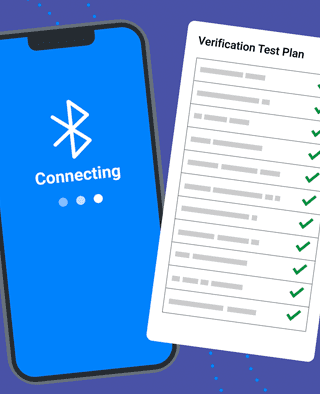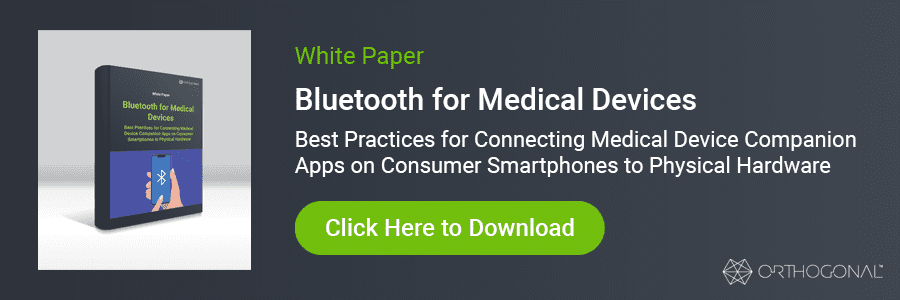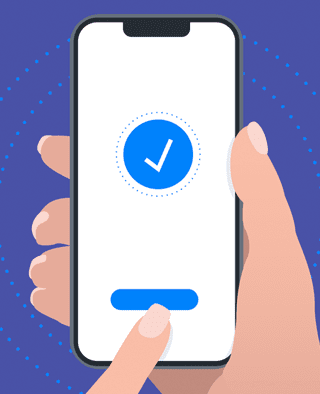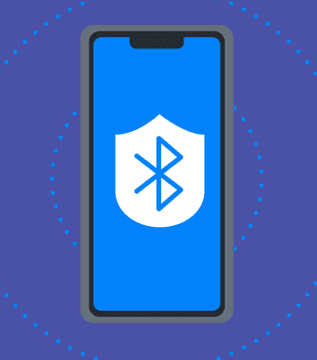
Article
Testing Strategies for Bluetooth Medical Devices
This blog contains Part 4 of the Orthogonal White Paper titled “Bluetooth for Medical Devices.” The following are links to each part of the white paper:
For more in-depth discussions on Bluetooth from medical device experts, visit our page on our Bluetooth Low Energy for Medical Devices Webinar Series, co-presented by MedSec.
– – –
Bluetooth-enabled medical devices with companion apps have rapidly become the norm across many clinical domains. Patients have more options than ever before, and they can afford to be picky when choosing an app that will meet their needs while also being easy to use and reliable.
The central question for connected medical device developers and manufacturers is how to optimize Bluetooth and the user experience to create a device that is both safe and effective and that patients will want to use. In Part 4 of this white paper, we’ll discuss the basics of User Experience and Patient Engagement for Bluetooth medical devices, as well as provide examples of where Bluetooth optimization and user experience overlap.
User Experience (UX) is the interaction that users have with a product or service. UX designers for Bluetooth-enabled medical devices use patient feedback and user testing to create a responsive and pleasing experience of using the connected device system.
Patient Engagement describes the “stickiness” of a medical device solution. An engaging device encourages patients to stick with the treatment and to interact with the app. On the flip side, a device and app that are not engaging will not be used by patients. Designing for patient engagement involves understanding how a medical device can fit into a patient’s everyday life, as well as taking a human-centered approach to design.
Patient Engagement and User Experience go hand in hand: UX designers work with patients to get a sense of their needs, wants and habits, and develop systems that engage those aspects of the patient experience.
For a deep dive on Patient Engagement, as well as best practices, listen to our podcast series on Patient Engagement and Medical Devices.
Bluetooth-enabled medical devices and companion mobile apps drive patient engagement by meeting user needs in a way that adds value to their lives. Crucially, it is the user’s needs that are being met. There are many ways apps can meet the needs of its manufacturers; for example, collecting patient data that can be used to improve device algorithms or app functions. But if an app exists only to aid the manufacturers, patients will choose not to use it.
Likewise, patients will stay away from apps that ask too much of them for not enough in return. Patients should not have to overhaul their routines in order to make the device work. The best connected medical device systems are unobtrusive and fit into the daily lives of its users.
As discussed in Part 1: Introduction to Bluetooth for Medical Devices, Bluetooth-enabled medical devices take advantage of both the power and ubiquity of smartphones. Patients already have a relationship with their smartphones, including how frequently they check it throughout the day, what kinds of apps they use and how they manage its power consumption, among other factors.
Connected medical device system developers need to think about how their app fits into not just patients’ lives but also their smartphone habits. An engaging companion app to a Bluetooth medical device will be one that a patient can easily slot into their existing smartphone routine.
Patients also look for device systems that are reliable and easy to use. Patients will not stick with a treatment if the user experience is prone to errors, shutdowns or dropped connections.

Patients use Bluetooth-enabled medical devices to take charge of managing their health. On paper, that may sound aligned with developers’ goal of “improving patient outcomes faster.” However, there are instances where user needs and the parameters of the device are at odds, including when Bluetooth impacts the user experience.
User needs and Bluetooth intersect anytime the device or app uses the Bluetooth connection to fulfill a user need.
For example, how does the system fulfill the user’s need to view device data on the app? Let’s assume the device peripheral and app have already paired over Bluetooth. The device peripheral sends data over Bluetooth to the smartphone. The OS wakes up the app in background mode and hands it the data. The app receives background processing time and responds to the peripheral device. When the user takes a look at their app in foreground mode, the updated information will be displayed.
How should Bluetooth be optimized to best meet users’ needs in this scenario? One optimization is around power. The more frequently the device peripheral and the app on the smartphone communicate, the larger the drain on both devices’ batteries. The same goes for the size of the data packet sent over Bluetooth; larger packets consume more power.
Patients may like getting frequent and up-to-date readings from their device peripheral, but may be less enthusiastic about constantly needing to charge their smartphone and device (or in some systems, replace the device). On the other hand, a system that infrequently relays data from the peripheral to the app as a concession to the battery life may make patients feel like they’re not getting value out of it.
There are also optimizations for when user needs are not met. As discussed in Part 2: Managing Edge Cases for Bluetooth Medical Devices, edge cases or “gotchas” are an inevitable occurrence when designing a computing system – even more so when that system runs on a smartphone, which medical device developers do not fully control. Some edge cases are easy to identify and mitigate, while others may only be found during testing and require extra attention to resolve.
Take the instance when multiple devices are connected to a single app. A parent may be using one app to monitor their own blood glucose level as well as that of their child. How does the user know which device is which when setting up the Bluetooth connection? How does the app manage the data coming from each CGM and apply it to the correct user’s chart? If one of the CGMs encounters a problem, can the parent identify which one? These are all edge cases that, if left unsolved, can negatively impact the user experience and potentially patient safety.
One place where Bluetooth optimization and UX intersect is when measures taken to secure the Bluetooth connection impact the ease of use of the device system.
As mentioned in Part 3: Cybersecurity for Bluetooth Medical Devices, the FDA prefers when developers implement the most secure configuration possible for their devices. For example, using an encrypted pass key to pair the medical device and app over Bluetooth versus using the default “Just Works” protocol. This helps safeguard the sensitive patient data stored on a connected device system from bad actors and hackers.
It can also make the pairing process more complicated and thus more difficult for users, especially those with limited technological literacy. Some patient populations may be frustrated with the steps necessary to pair their medical device and smartphone, which can lead to them abandoning the device.
The solution is not to discard the pass key method and revert to Just Works, as that will make it much harder to satisfy FDA regulators and to keep patient data safe. Neither is it to alienate patients with a complicated pairing scheme. Trade-offs will need to occur between a super-secure Bluetooth pairing that challenges less technologically experienced users and an easy pairing protocol that leaves the Bluetooth connection vulnerable to attacks.
A Bluetooth-enabled medical device may provide a novel and impactful treatment, but what may be even more critical to its market adoption is its optimization. A well-optimized app drives patient engagement that drives the effectiveness of the treatment. It also drives positive reviews on app stores, which may make new patients more interested in using it. Additionally, if patients provide positive feedback to their physicians who prescribed the app, physicians may be more likely to recommend it to other patients.
Here are some of Orthogonal’s recommendations for optimizing Bluetooth functionality and UX.
Part 2: Managing Edge Cases for Bluetooth Medical Devices discusses our best practices for identifying, testing and mitigating edge cases. For some edge cases, it’s possible to program or architect the medical device system to anticipate the edge case and prevent it from occurring. Some edge cases can’t be anticipated, however. When they happen, it’s important to be upfront and transparent about the failure. UX designers should collaborate with developers to gracefully recover from edge cases like these by providing guidance to the user.
As discussed in Part 3: Cybersecurity for Bluetooth Medical Devices, monitoring refers to architecting a system and/or deploying software solutions to look for anomalies, performance issues or areas where users are having difficulty in the device software. Monitoring provides quantitative data that informs qualitative user research. UX designers and software developers can take advantage of both sets of data to mitigate design and technical issues.
Monitoring solutions come in many forms, including:
Optimizing UX and Bluetooth for a Bluetooth-enabled medical device necessitates making trade-offs in the design. By being cognizant of users’ needs, it’s possible to create a smooth experience for both the medical treatment and the Bluetooth implementation.
– – –
This blog contains Part 4 of the Orthogonal White Paper titled “Bluetooth for Medical Devices.” The following are links to each part of the white paper:
Related Posts

Article
Testing Strategies for Bluetooth Medical Devices

Article
Patient Engagement & UX for Bluetooth Medical Devices

Article
Cybersecurity for Bluetooth Medical Devices

Article
How Design Can Improve Ratings for Medical Device Apps